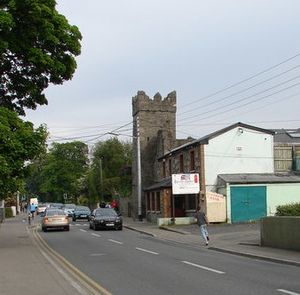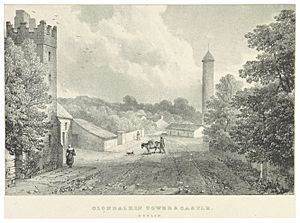Tully's Castle facts for kids
Quick facts for kids Tully's Castle |
|
|---|---|
| Native name Irish: Caisleán Uí Mhaoltuile |
|
| Clondalkin Castle | |

Monastery Road with Tully's Castle visible
|
|
| Type | Castle |
| Location | Monastery Road, Clondalkin, South Dublin, Ireland |
| Built | 16th century |
| Official name: Tully's Castle | |
| Reference no. | 285 |
| Lua error in Module:Location_map at line 420: attempt to index field 'wikibase' (a nil value). | |

Tully's Castle is an old castle found in Clondalkin, Ireland. It is also known as a National Monument, which means it's a special historical site protected by the country.
Contents
Where is Tully's Castle?
Tully's Castle is located on Monastery Road in Clondalkin. This area is part of South Dublin.
History of Tully's Castle
Tully's Castle was built a long time ago. It has a tall, narrow tower that was likely built in the 1500s. There's also a smaller building next to it, added around the 1600s.
What Does the Castle Look Like?
The tower has small, narrow windows. Most of these windows are now blocked up. This was common in old castles to make them safer from attacks. The top of the tower has damaged battlements. These are the parts that look like teeth, where defenders could stand and shoot arrows.
The tower might have been part of a larger tower house. Tower houses were popular in Ireland. They were strong, tall homes built to protect families during dangerous times. This tower might have held stairs or even a simple toilet, called a garderobe.
Today, the castle ruins are part of a garden wall. They belong to a modern house nearby.
Why Were Castles Built?
In the 1600s, Ireland was not always peaceful. There were often raids and conflicts. Castles like Tully's Castle gave families a safe place to live. They helped protect people and their belongings. The castle was especially important for families living near areas like The Pale, where there was often fighting.
Who Owned Tully's Castle?
The Tully family owned this castle for many years. They lived there during the 1700s and 1800s.

